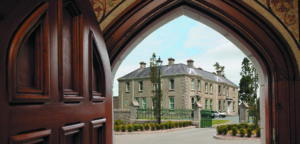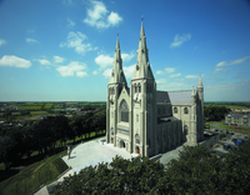11 November 2018
◦Service to be broadcast from 3:45pm by BBC1 NI and on BBC Radio Ulster
Earlier this year I was honoured to lay a wreath during the Last Post ceremony at the Menin Gate in Ypres with my friend Archbishop Richard Clarke and some of our young people. It was deeply moving for all of us, but still, it is difficult for any of us to imagine the thoughts and feelings of the young men on the battlefields of the First World War who heard the haunting tones of the Last Post each evening at sunset and, in the darkness, prayed for home, for family, for peace.
On our previous visit to Ypres back in 2016 I found the spot about five miles outside the town where my great uncle Edward is buried in Canada Farm cemetery. Because he was tall and strong from working on the farm in Donegal, they put him to operate the heavy guns of war. Today he lies, in Flanders fields, another young man among the half a million who perished in the infamous battle of Passchendaele, in the ‘flower of youth’.
At that time the chaplain wrote to my great granny to reassure her that her son Edward had received a Catholic burial “in a blessed grave with a proper cross”.
Last month in Rome I launched a new film about Father Willie Doyle SJ Chaplain to the Royal Dublin Fusiliers who also died at Passchendaele. He was struck by a shell as he crawled out to minister to two wounded men on ‘no man’s land’. By all accounts Father Doyle was a saintly priest who knew no fear and was greatly respected by the men, of all traditions. Somehow, despite the deafening bombardment and sickening stench of battle, Father Doyle was able to bring the gentle and comforting presence of Jesus into that hellish place. He once wrote in his personal diary: “I long to go and shed my blood for Jesus and, if he wills it, to die a martyr for charity … To do something great and heroic may never come, but I can make my life heroic by faithfully and daily putting my best effort into each duty as it comes round”.
Father Doyle’s body was never found. His name is inscribed at Tyne Cot with so many other brave and heroic people from north, south, east and west. As we remember them today I am comforted by the words of Saint Paul:
“Brothers and sisters we want you to be quite certain about those who have fallen asleep, to make sure that you do not grieve for them, as others do who have no hope. We believe that Jesus died and rose again, and that in the same way God will bring with him those who have fallen asleep in Jesus… At the signal given by the voice of the Archangel and the trumpet of God… we shall be with the Lord for ever (1 Thess 4)”.
My visits in recent years to the Somme and to Flanders, with Archbishop Richard and the other Church leaders, have really opened my eyes to the grief and suffering that was shared by families of all traditions and from every part of Ireland. Three granite blocks at the Peace Park in Messines remind visitors of those from across the island of Ireland who were killed, wounded or missing during the war: 32 thousand from the 36th Ulster division; 28 thousand from the 16thIrish division; 9 thousand from the 10th Irish division.
Sadly, because of the cruel twists and tensions of our history of conflict, the fact that Irish Catholics and Protestants fought and died, side by side, was neglected for too long – and perhaps conveniently – by all sides, both north and south of the border. People preferred to cling on to a history of difference and separation, rather than recognise and embrace our shared story of common suffering. That is why it was very moving for me to stand in Messines with the other Church leaders and to read with them these words from the Peace Pledge there:
“From the crest of this ridge … as Protestants and Catholics, we apologise for the terrible deeds we have done to each other and ask forgiveness … we appeal to all people in Ireland to help build a peaceful and tolerant society … we affirm that a fitting tribute to the principles for which men and women from the Island of Ireland died in both World Wars would be permanent peace.”
Gathered here this afternoon, in Belfast, let us renew that peace pledge, together, in our hearts. The brave people we are remembering are calling us to recognise their shared suffering by building a better future where difference is accepted and respected.
Although standing at war memorials, wearing poppies, laying wreaths and the Last Post may not have been part of my tradition or upbringing, to remember the dead, to honour and pray for them – especially during the month of November – is important to the practice of my faith. In recent years I have grown to understand more fully that, whilst we may remember in different ways, and whilst our forebears had differing and often conflicting approaches to the war, what unites us now in their memory is so much greater than anything that is talked up to divide us.
Can we learn from their shared sacrifice, a full century after the so-called “war to end all wars”? They have bequeathed us a shared responsibility for healing the past and building lasting trust and peace. Peace is not merely ‘ceasefire’ or the absence of violence and war. Peace is an ongoing work of reconciliation, justice and hope: it means coming out of our own trenches; building bridges, not parapets; “beating swords into ploughshares, spears into pruning hooks (Isaiah 2)”.
Jesus said, “Love one another as I have loved you (John 15)”. Peace is the fruit of that love which urges us to uphold the value and dignity of every human life and to be passionate about respecting others, especially those who are poor or marginalised. Our hope remains for a lasting peace on the island of Ireland. May Christ, the Prince of Peace, help us make that hope a reality for the youth of today and tomorrow. Amen.



You must be logged in to post a comment.